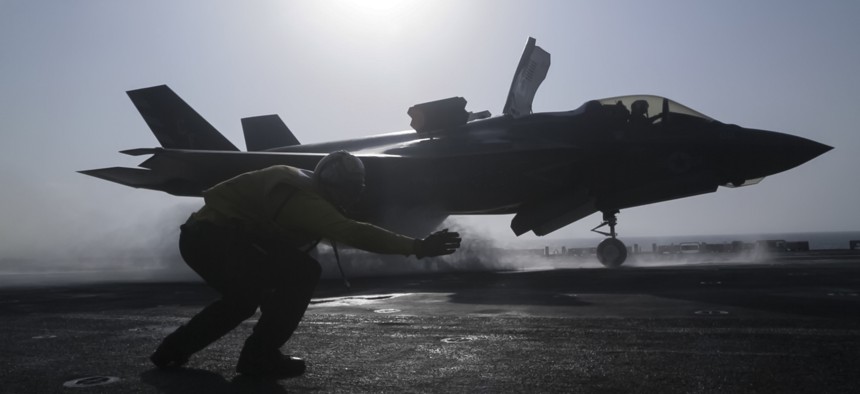
U.S. Navy Petty Officer 1st Class Rey White, an aviation boatswains mate handler with the Essex Amphibious Ready Group (ARG), launches an F-35B Lightning II with Marine Fighter Attack Squadron 211, 13th Marine Expeditionary Unit (MEU). U.S. Marine Corps photo by Cpl. Francisco J. Diaz Jr./U.S. Navy via AP
Why the S-400 and the F-35 Can’t Get Along
Today's radar systems and aircraft need to share a lot of information. That's a problem when the countries that produce them aren't on the same side.
U.S. military officials have repeatedly warned that Turkey’s purchase of Russia’s S-400 anti-aircraft system could compromise the F-35 fighter jet. But they haven’t gone into great detail about how.
In June, for example, Gen. Tod Wolters, who leads U.S. European Command, offered this explanation: “You cannot operate an F-35 in the vicinity of an S-400. They won’t talk to each other, and what the two systems will attempt to do, certainly the S-400 against the F-35, is attempt to exploit the F-35’s capabilities. I can tell you that we aren’t interested in sharing the F-35’s capabilities from a radar perspective, from an operational perspective, with the Russians. We’ve made that very, very clear.”
Yet Israeli F-35s have operated near Russian S-400s deployed to Syria.
The S-400 radars will be able to observe the F-35 “in all its flight profiles, thus being able to identify weak spots in stealth capability,” according to David Stupples, a professor of electronic and radio systems at City, University London and a member of the board of the Association of Old Crows, an association for radar and electronic warfare professionals.
Stupples said the dangers don’t stop in the air. Turkey will get five years of Russian technical support with its S-400 purchase, which will give Moscow ample opportunity to put intelligence agents next to those batteries and their operators, Stupples said. He said that this is a common problem in India, another S-400 client.
Michael Kofman, a senior research scientist at CNA, a nonprofit research and analysis organization in Arlington, Virginia, downplayed that concern. “We should consider that most likely the F-35 and the S-400 are not going to be anywhere near each other. Hence the proposition that Russian technicians are going to be working on the same base, co-located with F-35s, is a low- probability event.”
Stupples also worries about what would happen if Turkey were to integrate the S-400 with the NATO Air Defence Ground Environment, or NADGE, a group of radars and other sensors, targeting systems, communications links, friend-and-foe identification systems, etc.
“The capability criteria of the F-35 could be accessed by rogue IT technicians working on the S-400,” he says if that were to happen.
Another possible avenue for cyber attack are the systems that help differentiate allied aircraft from adversarial aircraft, a task that requires extensive data-sharing.
The integration of the S-400 and the NADGE could also allow Russian cyber operators to target F-35s flown by Turkey — and even other allies — via the maintenance software that connects the aircraft. “The risk here is significant and cannot be ignored,” Stupples says.
Kofman said the sword of data access swings both ways. “The issue of security, and access to technology, is just as problematic for Russia selling an S-400 to a NATO country as it is for the U.S. in the case of the F-35,” he said. “For some reason coverage tends not to ask the question of how are Russians planning to deal with the potential problem of U.S. intelligence being all over their system in Turkey.”
Yet while the U.S. officials have big reservations about co-locating the S-400 and the F-35, the Russian government has expressed no similar concern.
Kofman pointed out that the S-400 that the Russians are selling to Turkey is an export-approved version, slightly different from the one that the Russians are using.
“Russians are not crying about selling their best tech to a NATO country, despite the obvious implications for technology access. That should make us wonder,” he said.




